<< Previous | Displaying results 4876-4900 of 6769 for "" | Next >>
Members of the Bielski partisan group at the site of a mass grave shortly after liberation. Poland, 1945.
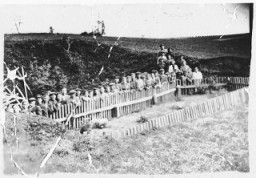
Postwar portrait of Piotr Kolenda. He was a landowner from Nowogrodek who knew both the Dzienciolski and Bielski families before the war. During the war he helped hide the women before they could safely go to the forest and continued to assist members of the Bielski group while they were in the forest.
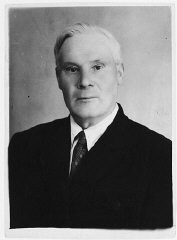
Wedding portrait of former Bielski partisan, Berl Kagan. Emden, Germany, April 3, 1948. Pictured from left to right are Ita Rubin (the bride), her mother, Sarah Rubin, and Berl Kagan. All three were passengers on the Exodus 1947.
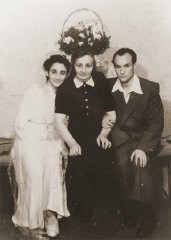
Portraits of Martha and Waitstill Sharp from an unknown newspaper. Published before they left for Europe on a relief mission with the Unitarian Service Committee.
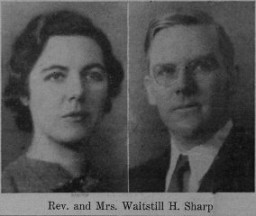
Polish-Jewish refugees seeking to leave Europe arrive in Lisbon. Following the German invasion of France, Jewish and non-Jewish refugee assistance organizations relocated their headquarters to Lisbon, the only neutral European port from which refugees could depart to North and South America. Lisbon, Portugal, June 21-22, 1940.
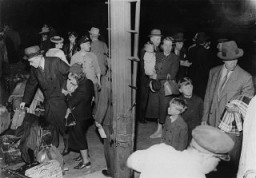
A wounded partisan is treated in a field hospital belonging to the Shish detachment of the Molotov brigade. Among those pictured are Dr. Ivan Khudyakov, the brigade's physician (second from the right), and Fanya Lazebnik (Faye Schulman), a photographer and partisan nurse (left). The wounded partisan's name is Sergei. Pinsk, 1942–44.
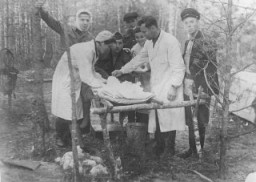
Group portrait of members of the Hashomer Hatzair socialist Zionist youth movement. Pictured in the back row, left to right, are: Tzvi Braun, Shifra Sokolka and Mordechai Anielewicz. Seated in front are Moshe Domb and Rachel Zilberberg ("Sarenka"). Warsaw, Poland, 1938.
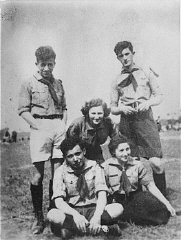
Zivia Lubetkin, a founder of the Jewish Fighting Organization (ZOB) and participant in the Warsaw ghetto uprising. Poland, date uncertain.
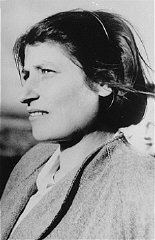
Yitzhak (Antek) Zuckerman, Zionist youth leader and a founder of the Jewish Fighting Organization (ZOB). He fought in the Warsaw ghetto uprising. Place and date uncertain.

Portrait of Josef Kaplan. Kaplan was a youth movement leader. He was also a leader of the Warsaw ghetto underground and Jewish Fighting Organization (ZOB). He was caught preparing forged documents and was killed. Poland, before September 1942.
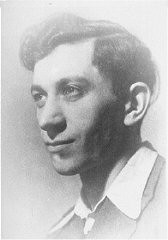
Portrait of Tosia Altman (1918-1943), Jewish youth leader and member of the Jewish underground in the Warsaw ghetto.
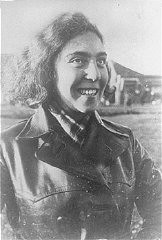
Cover of an underground Yiddish newspaper, Jugend Shtimme (Voice of Youth). Writing on the bottom of the cover reads: "Fascism must be smashed." Warsaw ghetto, Poland, January–February 1941.

Yitzhak Rochzyn (other spellings: Isaac Roszczyn and Icchak Rochczyn) youth group leader and leader of the Lachwa ghetto underground.
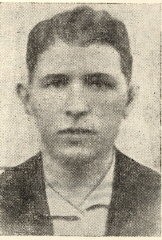
Alter Dvoretsky, head of the Zhetel Judenrat (Jewish council) and leader of the Zhetel underground.
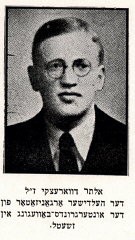
Benjamin Miedzyrzecki (Benjamin Meed), a member of the Jewish underground living in hiding on false papers, poses in Ogrod Saski (Saski Gardens) on the Aryan side of Warsaw. Poland, 1943.
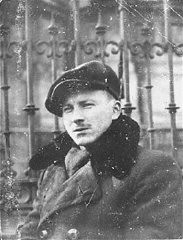
While living in hiding on the Aryan side of Warsaw, Benjamin Miedzyrzecki (Ben Meed) returns to the site of the Warsaw ghetto, where he poses among the ruins. Warsaw, Poland, 1944.

False identification card photo of Benjamin Miedzyrzecki (Benjamin Meed) as a member of the Warsaw ghetto underground. Warsaw, Poland, 1943.
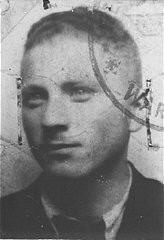
Vladka and Benjamin Meed (center) with President Jimmy Carter at a White House Rose Garden ceremony marking the official presentation of the report of the US Holocaust Commission to the president by commission chairman Elie Wiesel. Washington, DC, September 27, 1979.
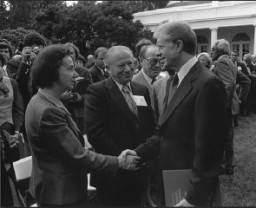
Members of the United States Holocaust Memorial Council pose with two milkcans containing a Scroll of Remembrance signed by Holocaust survivors at a symbolic groundbreaking ceremony for the United States Holocaust Memorial Museum. Benjamin Meed is second from the left. Washington, DC, April 30, 1984. During groundbreaking ceremonies in April 1985, the containers were buried on the site of the Museum.
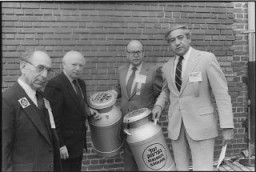
Benjamin Meed (right) and Harvey Meyerhoff stand next to the cornerstone for the United States Holocaust Memorial Museum. In October 1988, President Ronald Reagan spoke at a special ceremony held when the cornerstone of the Museum was laid, with construction beginning in July 1989 and ending in April 1993. Washington, DC, 1988.
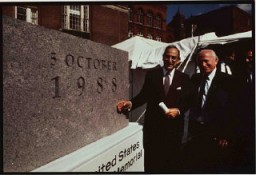
Members of the United States Holocaust Memorial Council pose with President George Bush (third from right) on the occasion of the 1989 Days of Remembrance. Benjamin Meed is fourth from the right. Washington, DC, 1989. Learn more about Days of Remembrance.
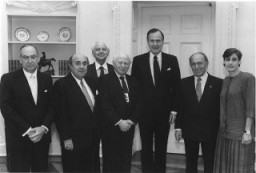
Laura Bush, George Bush, and Benjamin Meed during the Days of Remembrance ceremony in 2001, the theme of which was "Remembering the past for the sake of the future." Days of Remembrance was established by the United States Congress as the United States' annual commemoration of the victims of the Holocaust, just as the United States Holocaust Memorial Museum was established as a permanent living memorial to those victims.
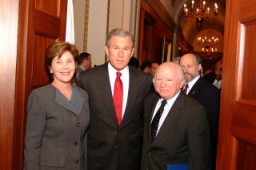
Benjamin Meed (left) with Fred S. Zeidman, Colin L. Powell, Elie Wiesel, and Ruth B. Mandel at the 2003 Days of Remembrance ceremony in the US Capitol Rotunda.
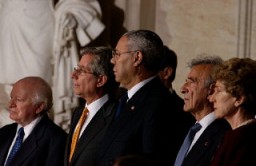
Benjamin Meed joins children in burying a time capsule during the Tribute to Holocaust Survivors: Reunion of a Special Family, one of the Museum's tenth anniversary events. Washington, DC, November 2003.
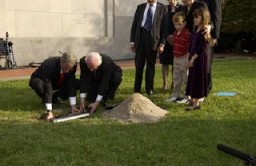
Benjamin Meed, Elie Wiesel (second and third from left), and two children bury a time capsule during the Tribute to Holocaust Survivors: Reunion of a Special Family, one of the Museum's tenth anniversary events. Washington, DC, November 2003.
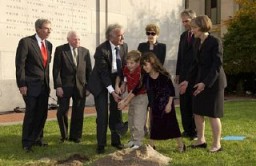
We would like to thank Crown Family Philanthropies, Abe and Ida Cooper Foundation, the Claims Conference, EVZ, and BMF for supporting the ongoing work to create content and resources for the Holocaust Encyclopedia. View the list of donor acknowledgement.